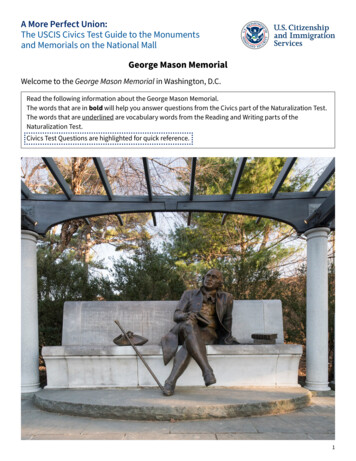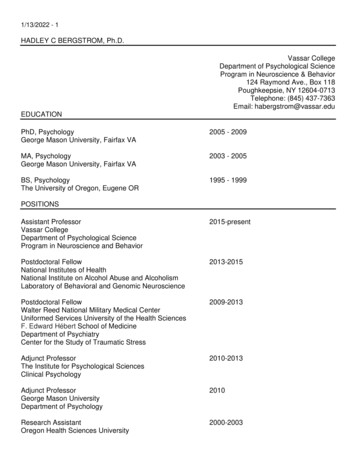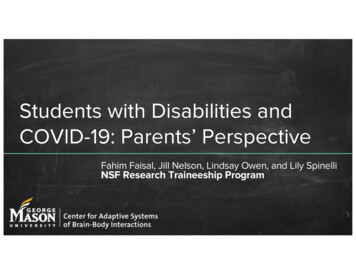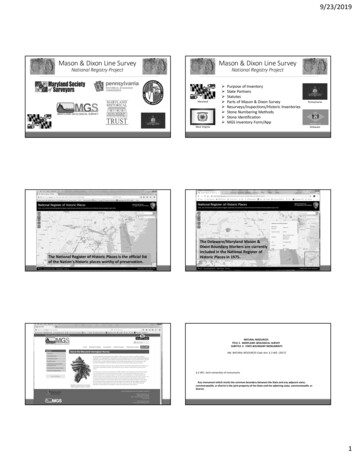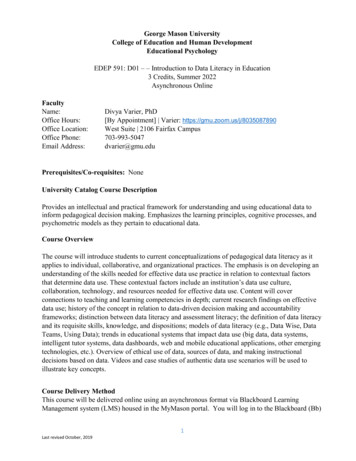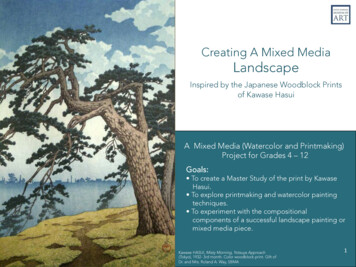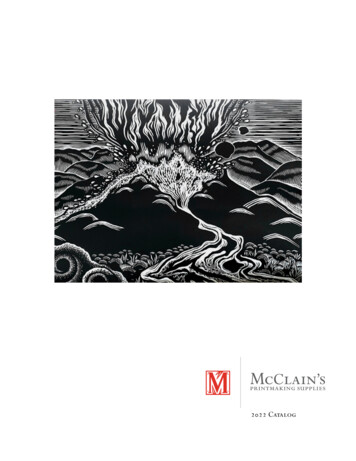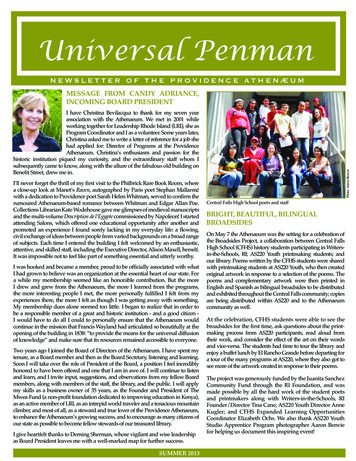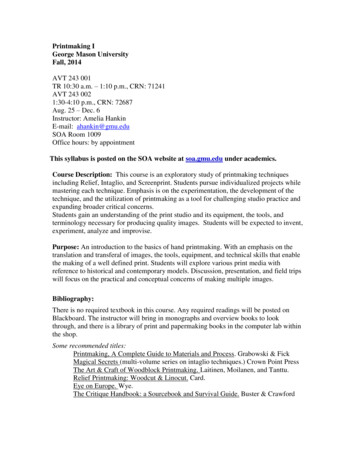
Transcription
Printmaking IGeorge Mason UniversityFall, 2014AVT 243 001TR 10:30 a.m. – 1:10 p.m., CRN: 71241AVT 243 0021:30-4:10 p.m., CRN: 72687Aug. 25 – Dec. 6Instructor: Amelia HankinE-mail: ahankin@gmu.eduSOA Room 1009Office hours: by appointmentThis syllabus is posted on the SOA website at soa.gmu.edu under academics.Course Description: This course is an exploratory study of printmaking techniquesincluding Relief, Intaglio, and Screenprint. Students pursue individualized projects whilemastering each technique. Emphasis is on the experimentation, the development of thetechnique, and the utilization of printmaking as a tool for challenging studio practice andexpanding broader critical concerns.Students gain an understanding of the print studio and its equipment, the tools, andterminology necessary for producing quality images. Students will be expected to invent,experiment, analyze and improvise.Purpose: An introduction to the basics of hand printmaking. With an emphasis on thetranslation and transferal of images, the tools, equipment, and technical skills that enablethe making of a well defined print. Students will explore various print media withreference to historical and contemporary models. Discussion, presentation, and field tripswill focus on the practical and conceptual concerns of making multiple images.Bibliography:There is no required textbook in this course. Any required readings will be posted onBlackboard. The instructor will bring in monographs and overview books to lookthrough, and there is a library of print and papermaking books in the computer lab withinthe shop.Some recommended titles:Printmaking, A Complete Guide to Materials and Process. Grabowski & FickMagical Secrets (multi-volume series on intaglio techniques.) Crown Point PressThe Art & Craft of Woodblock Printmaking. Laitinen, Moilanen, and Tanttu.Relief Printmaking: Woodcut & Linocut. Card.Eye on Europe. Wye.The Critique Handbook: a Sourcebook and Survival Guide. Buster & Crawford
In addition this course is designed to:1) Stimulate perceptual growth and visual awareness in the student.2) Identify printmaking tools, methods, materials, and mediums as well as demonstrateskill and craft in their usage.3) Conceptualize an idea and then compose it into an aesthetically resolved artwork.4) Use creative process, including experimentation, to analyze and solve problems andexplain why creativity is an important mode of human expression.5) Utilize digital software and technology for research and image manipulation.6) Apply a set of criteria to evaluate a work of art.7) Utilize recommended health and safety practices, and demonstrate the ability to workcooperatively with others in a Printmaking Studio setting.8) Demonstrate reasonable oral and written skills using correct Printmaking terminology.9) Demonstrate an awareness of the art making traditions of various cultures.10) Create a portfolio of work that can be used for job and/or educational placement.Student Participation and Evaluation: Students develop a suite of prints or otherrelated investigation in tandem with their studio work or based on a theme of theinstructor’s choosing or their own in consultation with the instructor.Students are required to keep all of their work completed throughout the semester.Critiques and portfolio reviews will be the primary method of student evaluation. Sinceevaluation is based on work done in class, class attendance is mandatory. It isimportant to be on time since all demonstrations will be conducted at the beginning ofclass. If the student is 20 minutes late they will be counted as absent.This class fulfills a General Education Core requirement for Arts. Core requirementshelp ensure that students become acquainted with the broad range of intellectual domainsthat contribute to a liberal education. By experiencing the subject matter and ways ofknowing in a variety of fields, students will be better able to synthesize new knowledge,respond to fresh challenges, and meet the demands of a complex world.Arts goal: Mason courses in the film making, visual and performing arts stressgenerative, inquiry based learning through direct aesthetic and creative experience in thestudio environment. Courses aim to achieve a majority of the following learningoutcomes: students will be able to identify and analyze the formal elements of a particularart form using vocabulary appropriate to that form; demonstrate an understanding of therelationship between artistic technique and the expression of a work’s underlyingconcept; analyze cultural productions using standards appropriate to the form and culturalcontext; analyze and interpret material or performance culture in its social, historical, andpersonal contexts; and engage in the artistic process, including conception, creation, andongoing critical analysis.
Requirements:1) 8.5” x 11” sketchbook/notebook for ideas, lecture notes, diary entriesPrint Projects - Completed on time.2) Participation in all classes, visiting artists, discussions and critiques3) Care and Maintenance of the Print Studio4) Twelve hours (minimum) per week outside of class required (4 credits)5) One 2-4 page paper an artist’s print viewed during the Library of Congress fieldtrip6) 1 Documented Artists Report for Visiting Artists/Lecture (Carmon Colangelo, Oct. 16)7) One ArtsBus trip to New York is required if an AVT MajorShop Rules & SafetyUse solvents and acids only in designated areas.Wash hands thoroughly with soap after working with ink and solvents.Always thoroughly clean your station after printing.Keep clean paper areas clean.Do not place hot plates on glass tables.Wear gloves and protective eye wear when using the acid baths.Wear mask when applying aquatint.Place newsprint over print when running it through the press. Do not get ink on press blankets.Immediately after running print through press, wipe off the press bed.Do not leave anything on the press bed; tape, ink, plate etc.Remove prints from racks as soon as they are dry.Dispose of trash in proper bins. There are special bins for solvent-soaked rage, paper scraps andregular trash.Course OutlineI.IntroductionDiscussion of printmaking as both a formal study and a tool forexploration of other media. Emphasis on developing expressive markmaking, cultivating personal style, and drawing from experience.II.Relief printmaking: Linoleum block printsRelief is explored as a medium that embraces the aesthetics of line, shape,and space. Students receive instruction on learning the process of printingthrough in-class demonstrations that include: carving, printing, andeditioning.III.IV.Intaglio printmaking: Drypoint and EtchingEtching involving hardground, aquatint and reworking of images isexplored. Students learn multiple-state biting of zinc plates, proper platewiping technique, chine colle, and editioning.Screenprinting: Working with photo transparencies and drawingsScreenprinting is explored as a versatile medium that always the student towork with layers of information and colors. The exploration ofscreenprinting techniques will involve preparing your artwork for screen-
printing, coating and exposing a screen, and executing a one to two-colorscreen print.V.Final Print Exchange, Portfolio Critique, and ReviewMATERIALS LIST1. A flat file drawer will be provided for you to store your paper and prints made duringthe course.2. There are lockers in the hallway available for rental.3. The following are provided: 1 zinc plate, 1 copper plate, 1 linoluem block, Screens forscreenprinting, some newsprint, printing ink, 1 sheet of Rives BFK, 1 sheet of proofingpaper. Some tools are available to borrow. Many consumables are provided.Students are responsible for supplying the following items:(LABEL YOUR SUPPLIES WITH YOUR INITIALS)Sketchbook/journal 8.5 x 11Sketching media: graphite pencils, markers, pens, charcoal etc.)Sharpee marker1 sheet of clear/tranparent film, 18” x 24”Small pad of tracing paper18” x 24” pad of newsprint1 Combination Etching Needle and Burnisher1 Set of Speedball Linoleum Cutter with 5 blades1 Rubber Speedball Roller 4” or 6”Artist tape or painter’s tape1-2 packages of Playtex blue long Nitrile disposable gloves (no powder)One Portfolio Case, approx. 23”x31” (to transport and hold your prints)Tool box/tackle box for suppliesOne X-acto knife with 11# bladeOne pgk. X-acto bladesStretched screen (provided)2 palette knivesOpt. apron or work clothesOpt. scissorsPrintmaking Paper:Rives BFK (22 x 30”) or equivalent 225-300 lb western printmaking paperFive Sheets 22”x30” Rives BFK White Printmaking Paper2-3 Sheets 22”x30” Rives Gray Printmaking Paper2-3 Sheets 22”x30” Rives Tan Printmaking PaperRice paper:Provided
Art Supply StoresPlaza Art (recommended and close to campus)3045 Nutley StreetPan Am Shopping CenterFairfax (703) 280-4500University BookstoreJohnson Learning CenterGMU Campus(701) 993-2668Online storesMcClain’s Printmaking Supplieswww.imcclains.com310-998-0098Hiromi Paper sance Graphic Arts, Inc.www.printmaking-materials.com(215) 357-5705Rice Printmaking Paper: You can find rice paper at Plaza Arts, Utrecht, but notnecessarily at craft stores. Look for unadorned paper in white or natural with a soft, mattesurface. Mulberry, Thai Mulberry, Kozo, Kitakata, Okawara, Hosho are available locally.You can also mail-order these papers. They can get quite expensive, so look for a sheetthat is around 24 x 36” and under 5. You will need two sheets. Note that the dimensionsis not universal, so each “brand” may be a different size. Masa is very cheap, but looks it.Sekishu is excellent, but more expensive. A sheet of Okawara and Kitakata each wouldbe a good bet.Western Printmaking Paper: There are many types of western printmaking papersavailable locally. Standard is Rives BFK, available in several colors. Also look forArches Cover, Somerset Satin or Velvet, Fabriano Rosaspina or Tiepolo, or for thebudget-minded: Rives HWT, Rives LWT. Stonehenge, although inexpensive, is better fordrawing & screenprint, but acceptable for block-printing. If you cannot spare the moneyfor the better paper, then buy 4 sheets of Stonehenge or Folio (a domestic proofingpaper), and 4 sheets of Rives HWT. Western paper’s standard size is 22 x 30 (with theexception of Rives HWT and LWT), and should run between 4- 5. You will need 8-10sheets. You don’thave to buy them all at once; four sheets will do to start. Choose somewhite sheets, and augment with a cream and a grey color. These papers can be mailordered.
Grading CriteriaEvaluation of your projects (all projects) will constitute 50% of your grade - 15% will be forimprovement and 35% will be for all over quality of concept, craft and expression. Your level of classparticipation will constitute the remaining 50% of the grade.F 1/3rd of the course assignments have not been successfully completed - your level of participation isnot acceptable for university study;D most assignments have been competed - your level of success and/or class participation is belowaverage;C all assignments have been completed on time - your level of success, attendance and classparticipation is average for GMU;B assignments have been completed at levels above average for GMU, work shows some initiative, isvery well presented & demonstrates a clear understanding of the assignment, regular attendance,your class participation raised the level of the class;A a remarkable achievement measured on a national scale - achieved extraordinary initiative, originalthought and extra effort - you demonstrated leadership in the classPortfolio Of Projects - Overall (50%) General Improvement (25%)Class Participation (25%) Absences / Shop Care (Diminished grade)Class ParticipationClean UpStudents are responsible for cleaning up after themselves so that the room is ready for the nextclass. At the end of the semester, please thoroughly clean out your locker/file. Do not leaveanything behind.CritiquesWe will hold periodic informal critiques throughout the semester. The critiques are designed tohelp students improve their work and develop a vocabulary to discuss their own work as well asthe work of their classmates. Participating in the critiques is mandatory.Field Trips and Art EventsCourse research will include the study of exhibitions in DC museums and other sites.Library of Congress Field-trip*A mandatory field trip to the Library of Congress will be scheduled mid-semester, TBA. Wewill meet with Katherine Blood, Curator of Fine Prints, to view selected fine art prints from OldMasters to contemporary. Website: www.loc.gov/pictures. A 2-4 page paper analyzing a printviewed at the Library of Congress is due at the end of the semester on Dec. 4.Arts Bus:Three opportunities for Saturday Trips to NYC throughout the semester.See syllabus or http://artsbus.gmu.edu for information; AVT majors arerequired to go once/semester.Artbus dates:September 20, October 18, November 15Visual Voices:The Visual Voices Lecture series offers five talks on Thursday eveningsthroughout the semester. See the schedule at the end of this syllabus.GMU Art Events:Information on recommended trips and art events at GMU will be
announced and distributed. Show announcements are often posted on thebulletin board or on the flat files.Special Collections: The Printmaking Dept. offers several opportunities to visit specialcollections at area museums. These trips are outside of class-time.GMU Print Guild: Open to students, alumni, and public ( 25 annual membership.) The Guildmeets regularly on Friday, and members can use the studio on Friday and Saturday. Please takeadvantage of this lively organization and join them in events, shows, workshops, and projects. Ifyou are working in the studio on weekends, you’ll find they offer a wealth of informationJournal/SketchbookStudents are required to keep a journal or sketchbook. It should be brought to class every weekand used to explore creative ideas, keep notes on demos, problem solve etc. Basically, includeanything and everything that relates to processes, techniques, readings, and ideas that arise frompracticing and thinking about printmaking. I encourage you to use the sketchbook for your ownpersonal exploration of concepts and media. Ultimately, your sketchbook provides a place todocument your visual development and experiences during class but most importantly allowsideas to grow.Final Evaluation/Portfolio Review (Dec. 4)The final evaluation will be based on your final projects for each printmaking technique:linoleum blocks, drypoint, etching, and screenprints. The portfolio of work should be arrangedin chronological order containing all in and out-side of class work. Portfolios are used toevaluate your effort, productivity, and progress. 2-4 page paper due.** Be sure to save all of your work throughout the semester and store it in a flat file drawer.IMPORTANT DATES:Consortium Registration DeadlineAugust 8First day of classes; last day to submit Domicile Reclassification Application; Payment Due DateAugust 25Labor Day, university closedSeptember 1Last day to add classes—all individualized section forms dueLast day to drop with no tuition penaltySeptember 2Last day to drop with a 33% tuition penaltySeptember 16Final Drop Deadline (67% tuition penalty)September 26Midterm progress reporting period (100-200 level classes)—grades available via Patriot WebSeptember 22 October 17Selective Withdrawal Period (undergraduate students only)September 29 October 24Columbus Day recess(Monday classes/labs meet Tuesday. Tuesday classes do not meet this week)October 13Incomplete work from spring/summer 2014 due to instructorOctober 24Incomplete grade changes from spring/summer 2014 due to registrarOctober 31Thanksgiving recessNovember 26 – 30
Last day of classesDecember 6Reading DaysReading days provide students with additional study time for final examinations. Faculty may schedule optionalstudy sessions, but regular classes or exams may not be held.December 8 – 9Exam PeriodWed December 10 –Wed December 17Degree Conferral DateDecember 18Class Schedule:Week One (Aug. 26, 28)Tues. - Introduction to the course (supply list, syllabus)Walk through of the print shop.Discussion of printmaking as both a formal study and a tool for exploration of other media.There will be an emphasis on cultivating personal style and drawing from experience. Studentsmust keep drawing journal to be used for projects. Examples of linocut prints are shown in class.Thurs. – Demonstration of the linocut technique. Abstract pattern/Repetition – projectdiscussed.Come to class with supplies.Visual Voices: August 28 Anne Smith, Jay Hendrick, Sarah Irvin, Patrick SargentNow:Praxis in the Mason Studios”“Here andWeek Two (Sept. 2, 4)Linocut continued. Paper preparation, inking the block and printing (both by hand and press) aredemonstrated in class. Class time devoted to work time.Create an edition of 5 prints.Visual Voices: September 4 Rob Graziani“E(ART)H HistoryWeek Three (Sept. 9, 11)Tues. – Multi-color printing of one block. Create an edition of 5 prints.Thurs. – Lino continued, printing day.Week Four (Sept. 16, 18)Tues. - Thurs. – Critique. Intro. to Intaglio. Self-portrait: Narrative and allegory-projectdiscussed. Edition of 5 prints expected for midterm review.Demo on plate preparation and working the plate.Visual Voices: September 18 Dale Culleton “Improvising a Living Beyond the Studio”Week Five (Sept. 23, 25)Tues. Thurs. – Studio time to work on projects. Demo on printing and paper. Ink preparation,proper wiping techniques as well as paper preparation is covered. Wiping of plates is begun bystudents. Press printing is demonstrated.
Week Six (Sept. 30, Oct. 2)Tues./Thurs.- Studio time to work on project.Week Seven (Oct. 7, 9)Tues./Thurs – Studio time to work. Intro. to next project: Inspired by a current politicalsituation, students tackle the idea of social awareness and how the “power of multiples” can beused to bring awareness to the issue. Works by Jacque Callot, Francisco Goya, Daniel Heyman,and Sandow Birk are discussed. Print an edition of five.Hardground Etching – Various line making techniques are explored. Instruction on the use ofacids is given with emphasis on achieving line weight, gauging biting times and the use of stopout.Week Eight (Oct. 14, 16)No class, Tues., Oct. 14Thurs: Class time to work on drypointsThursday night: Visual Voices (mandatory): October 16 Carmon Colangelo“Psychogeographies:Jack Kerouac, Sputnik & Disneyland”Week Nine (Oct. 21, 23)Tues./Thurs – Mid-term evaluations. Edition of b&w linocut prints, multi-color lino prints, anddrypoints.Etching continuedVisual Voices: October 23 Ann Fesler“A Girl Like Her”Week Ten (Oct. 28, 30)Project continued. Intro. to softground Etching – Demo on how to create texture and pattern.Inking plate and press print the image. Students incorporate technique into their print. Aquatint– as a means of introducing painterly techniques onto linear medium. Demonstration of spraypaint. Aquatinting process, including grain control, tone control and manipulation through stopout techniques are covered. Students use drawings from journal to execute aquatint space studyover hardground image.Week Eleven (Nov. 4, 6)Etching continued. Critique.Week Twelve (Nov. 11, 13)Introduction to screen printing.Week Thirteen (Nov. 18, 20)Screen printingWeek Fourteen (Nov. 25, 27)Tues: screenprintingThurs: Thanksgiving Recess
Week Fifteen (Dec. 2, 4)ScreenprintingDec. 4: Final Critique of screenprints2-4 page paper dueHand in one of your most successful prints from each technique: Linoleum, Drypoint. Etching,ScreenprintInformal Print Exchange between studentsUniversity PoliciesUniversity and School of Art PoliciesIn accordance with George Mason University policy, turn off all beepers, cellular telephonesand other wireless communication devices at the start of class. The instructor of the class willkeep his/her cell phone active to assure receipt of any Mason Alerts in a timely fashion; or in theevent that the instructor does not have a cell phone, he/she will designate one student to keep acell phone active to receive such alerts.Commitment to DiversityThis class will be conducted as an intentionally inclusive community that celebrates diversityand welcomes the participation in the life of the university of faculty, staff and students whoreflect the diversity of our plural society. All may feel free to speak and to be heard without fearthat the content of the opinions they express will bias the evaluation of their academicperformance or hinder their opportunities for participation in class activities. In turn, all areexpected to be respectful of each other without regard to race, class, linguistic background,religion, political beliefs, gender identity, sex, sexual orientation, ethnicity, age, veteran’s status,or physical ability.Statement on Ethics in Teaching and Practicing Art and DesignAs professionals responsible for the education of undergraduate and graduate art and designstudents, the faculty of the School of Art adheres to the ethical standards and practicesincorporated in the professional Code of Ethics of our national accreditation organization, TheNational Association of Schools of Art and Design (NASAD).Open Studio HoursSOA teaching studios are open to students for extended periods of time mornings, evenings andweekends whenever classes are not in progress. Policies, procedures and schedules for studio useare established by the SOA studio faculty and are posted in the studios.ArtsBus Credit Each student must have up to 5 AVT 300/Artsbus credits before graduation. For credit toappear on your transcript you must enroll in AVT 300. This also applies to anyone whointends to travel to New York independently, or do the DC Alternate Assignment.
If you plan/need to go on multiple ArtsBus trips during a semester and need themtowards your total requirement, you must enroll in multiple sections of AVT 300. Pleasego to the ArtsBus website: http://artsbus.gmu.edu "Student Information" for additional,very important information regarding ArtsBus policy. Non-AVT majors taking art classes do not need Artsbus credit BUT may need to go onthe Artsbus for a class assignment. You can either sign up for AVT 300 or buy a ticketfor the bus trip at the Center of the Arts. Alternate trips must be approved by theinstructor of the course that is requiring an ArtsBus trip.Visual Voices Lecture Series Fall 2014Visual Voices is a year-long series of lectures by artists, art historians and others aboutcontemporary art and art practice. Visual Voices lectures are held on Thursday evenings from7:20- 9:00 p.m. in Harris Theater.August 28 Anne Smith, Jay Hendrick, Sarah Irvin, Patrick Sargent “Here and Now:Praxis inthe Mason Studios”September 4 Rob Graziani “E(ART)H HistorySeptember 18 Dale Culleton “Improvising a Living Beyond the Studio”October 16 Carmon Coangelo “Psychogeographies:Jack Kerouac, Sputnik & Disneyland”October 23 Ann Fesler “A Girl Like Her”Important DeadlinesLast Day to AddTuesday, September 2Last Day to Drop (No Tuition Penalty) Tuesday, September 2Selective Withdrawal Period – September 29- October 24Incomplete work from Spring 2014 due to instructor Once the add and drop deadlines have passed, instructors do not have the authority to approverequests from students to add or drop/withdraw late. Requests for late adds (up until the last dayof classes) must be made by the student in the SOA office (or the office of the departmentoffering the course), and generally are only approved in the case of a documented universityerror (such as a problem with financial aid being processed) , LATE ADD fee will apply.Requests for non-selective withdrawals and retroactive adds (adds after the last day of classes)must be approved by the academic dean of the college in which the student’s major is located.For AVT majors, that is the CVPA Office of Academic Affairs, Performing Arts Building A407.Students with Disabilities and Learning DifferencesIf you have a diagnosed disability or learning difference and you need academicaccommodations, please inform me at the beginning of the semester and contact the DisabilitiesResource Center (SUB I room 234, 703-993-2474). You must provide me with a faculty contactsheet from that office outlining the accommodations needed for your disability or learningdifference. All academic accommodations must be arranged in advance through the DRC.Official Communications via GMU E-MailMason uses electronic mail to provide official information to students. Examples includecommunications from course instructors, notices from the library, notices about academicstanding, financial aid information, class materials, assignments, questions, and instructor
feedback. Students are responsible for the content of university communication sent to theirMason e-mail account, and are required to activate that account and check it regularly.Attendance PoliciesStudents are expected to attend the class periods of the courses for which they register. In-classparticipation is important not only to the individual student, but also to the class as a whole.Because class participation may be a factor in grading, instructors may use absence, tardiness, orearly departure as de facto evidence of nonparticipation. Students who miss an exam with anacceptable excuse may be penalized according to the individual instructor's grading policy, asstated in the course syllabus.Honor CodeStudents in this class are bound by the Honor Code, as stated in the George Mason UniversityCatalog. The honor code requires that the work you do as an individual be the product of yourown individual synthesis or integration of ideas. (This does not prohibit collaborative work whenit is approved by your instructor.) As a faculty member, I have an obligation to refer the namesof students who may have violated the Honor Code to the Student Honor Council, which treatssuch cases very seriously.No grade is important enough to justify cheating, for which there are serious consequences thatwill follow you for the rest of your life. If you feel unusual pressure about your grade in this orany other course, please talk to me or to a member of the GMU Counseling Center staff.Using someone else’s words or ideas without giving them credit is plagiarism, a very seriousHonor Code offense. It is very important to understand how to prevent committing plagiarismwhen using material from a source. If you wish to quote verbatim, you must use the exact wordsand punctuation just as the passage appears in the original and must use quotation marks andpage numbers in your citation. If you want to paraphrase or summarize ideas from a source, youmust put the ideas into your own words, and you must cite the source, using the APA or MLAformat. (For assistance with documentation, I recommend Diana Hacker, A Writer’s Reference.)The exception to this rule is information termed general knowledge—information that is widelyknown and stated in a number of sources. Determining what is general knowledge can becomplicated, so the wise course is, “When in doubt, cite.”Be especially careful when using the Internet for research. Not all Internet sources are equallyreliable; some are just plain wrong. Also, since you can download text, it becomes very easy toinadvertently plagiarize. If you use an Internet source, you must cite the exact URL in your paperand include with it the last date that you successfully accessed the site.Writing CenterStudents who are in need of intensive help with grammar, structure or mechanics in their writingshould make use of the services of Writing Center, located in Robinson A116 (703-993-1200).The services of the Writing Center are available by appointment, online and, occasionally, on awalk-in basis.The Collaborative Learning HubLocated in Johnson Center 311 (703-993-3141), the lab offers in-person one-on-one support for
the Adobe Creative Suite, Microsoft Office, Blackboard, and a variety of other software. Dualmonitor PCs make the lab ideal for collaborating on group projects, Macs are also available; aswell as a digital recording space, collaborative tables, and a SMART Board. Free workshops arealso available (Adobe and Microsoft) through Training and Certification; visit ittraining.gmu.eduto see the schedule of workshops and to sign up.
McClain's Printmaking Supplies www.imcclains.com 310-998-0098 Hiromi Paper International www.hiromipaper.com 503-641-3555 Renaissance Graphic Arts, Inc. www.printmaking-materials.com (215) 357-5705 Rice Printmaking Paper: You can find rice paper at Plaza Arts, Utrecht, but not necessarily at craft stores.
